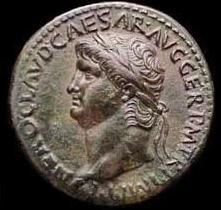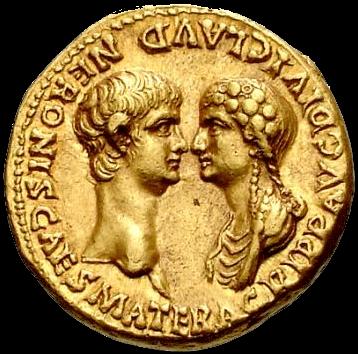
Nero Claud[ius] Caesar Aug[ustus] Ger[manicus] P[ontifex] M[aximus] Tr[ibunis] P[otentia] Imp[erator]
Commissioned by the Roman Emperor Nero to be built after the Great Fire of Rome in 64 AD, the Domus Aurea, or Golden House, was an extremely lavish palace, whose grounds covered approximately a square mile. The new palace featured areas such as forests, a man-made lake (which was large enough to fit battleships used for performances), and vineyards. Seutonius claimed in The Life of Nero that:
When the edifice was finished in this style and he dedicated it, he deigned to say nothing more in the way of approval than that he was at last beginning to be housed like a human being.
Prior to the Great Fire, Nero’s Palace was known as the Domus Transitoria, or the House of Passage, and ranged from the Palatine Hill to the Esquiline Hill. The Great Fire however allowed Nero to rebuild and extend the grounds of his palace, which would now include the rest of the Palatine Hill, the Caelian Hill, as well as space in the valley between the two hills. Nero commissioned a 120-foot bronze statue of his likeness to be built by the entrance to the palace. This statue was designed to imitate the Colossus of Rhodes. It is rumored that this statue of Nero resembled later depictions of Sol, the Roman sun god.
Celer and Severus were the two architects commissioned for the construction of the ornate palace. According to Tacitus’ Annals, Nero was quite involved in the design of the Domus Aurea, and actually oversaw Celer and Severus’ work to make sure every detail was just right. The house was used quite often for parties (thrown by Nero), as there were many open spaces and rooms for the common people to use. This made Nero quite popular with average Roman citizens. One of the most impressive spaces was the Octagon Room, which supposedly included a mechanism that, when operated by a team of slaves, would make the ceiling in the dome of room revolve like the heavens.
The construction of the palace was actually never finished. After Nero’s suicide in 68 AD, the new emperor Vespasian gave the land back to the public. The palace and the grounds were filled with earth, and soon the Baths of Trajan, the Baths of Titus, and the Coliseum were to be built over the house. Seen as an embarrassment to Nero’s successors, the Domus Aurea was stripped of all its marble, jewels and ivory within the decade after Nero’s death. As for the 120-foot statue of Nero, its face was changed and actually moved by Hadrian to outside the Flavian Amphitheater.
When a Roman teenager stumbled upon the Domus Aurea in the late 15th century, the early Italian Renaissance artists were quick to study the illustrations on the ceilings and walls of the house. Artists including Michelangelo and Raphael translated what they had seen in the Domus Aurea to their own work, especially their frescoes found in Vatican City.
_______________________________________________________________________________________

Gold coin depicting Nero and his mother, Agroppina
Suetonius describes the scale and opulence of the Domus:
There was nothing however in which he was more ruinously prodigal than in building. He made a palace extending all the way from the Palatine to the Esquiline, which at first he called the House of Passage, but when it was burned shortly after its completion and rebuilt, the Golden House. Its size and splendour will be sufficiently indicated by the following details. Its vestibule was large enough to contain a colossal statue of the emperor a hundred and twenty feet high; and it was so extensive that it had a triple colonnade a mile long. There was a pond too, like a sea, surrounded with buildings to represent cities, besides tracts of country, varied by tilled fields, vineyards, pastures and woods, with great numbers of wild and domestic animals. In the rest of the house all parts were overlaid with gold and adorned with gems and mother-of‑pearl. There were dining-rooms with fretted ceils of ivory, whose panels could turn and shower down flowers and were fitted with pipes for sprinkling the guests with perfumes. The main banquet hall was circular and constantly revolved day and night, like the heavens. He had baths supplied with sea water and sulphur water. When the edifice was finished in this style and he dedicated it, he deigned to say nothing more in the way of approval than that he was at last beginning to be housed like a human being.
He also began a pool, extending from Misenum to the lake of Avernus, roofed over and enclosed in colonnades, into which he planned to turn all the hot springs in every part of Baiae; a canal from Avernus all the way to Ostia, to enable the journey to be made by ship yet not by sea; its length was to be a hundred and sixty miles and its breadth sufficient to allows ships with five banks of oars to pass each other. For the execution of these projects he had given orders that the prisoners all over the empire should be transported to Italy, and that those who were convicted even of capital crimes should be punished in no other way than by sentence to this work. He was led to such mad extravagance, in addition to his confidence in the resources of the empire, by the hope of a vast hidden treasure, suddenly inspired by the assurance of a Roman knight, who declared positively that the enormous wealth which queen Dido had taken with her of old in her flight from Tyre was hidden away in huge caves in Africa and could be recovered with but trifling labour.
Life of Nero, 31.1-2
Pliny the Elder, a contemporary of Nero, expresses his outrage with the project:
But there are still two other mansions by which all these edifices have been eclipsed. Twice have we seen the whole City environed by the palaces of the Emperors Caius and Nero; that of the last, that nothing might be wanting to its magnificence, being coated with gold. Surely such palaces as these must have been intended for the abode of those who created this mighty empire, and who left the plough or their native hearth to go forth to conquer nations, and to return laden with triumphs! men, in fact, whose very fields even occupied less space than the audience-chambers of these palaces.
Natural History, 24
The historian Tacitus describes the ambitious Emperor's vision:
Nero meanwhile availed himself of his country's desolation, and erected a mansion in which the jewels and gold, long familiar objects, quite vulgarised by our extravagance, were not so marvelous as the fields and lakes, with woods on one side to resemble a wilderness, and, on the other, open spaces and extensive views. The directors and contrivers of the work were Severus and Celer, who had the genius and the audacity to attempt by art even what nature had refused, and to fool away an emperor's resources. They had actually undertaken to sink a navigable canal from the lake Avernus to the mouths of the Tiber along a barren shore or through the face of hills, where one meets with no moisture which could supply water, except the Pomptine marshes. The rest of the country is broken rock and perfectly dry. Even if it could be cut through, the labour would be intolerable, and there would be no adequate result. Nero, however, with his love of the impossible, endeavoured to dig through the nearest hills to Avernus, and there still remain the traces of his disappointed hope.
Annals 15.42